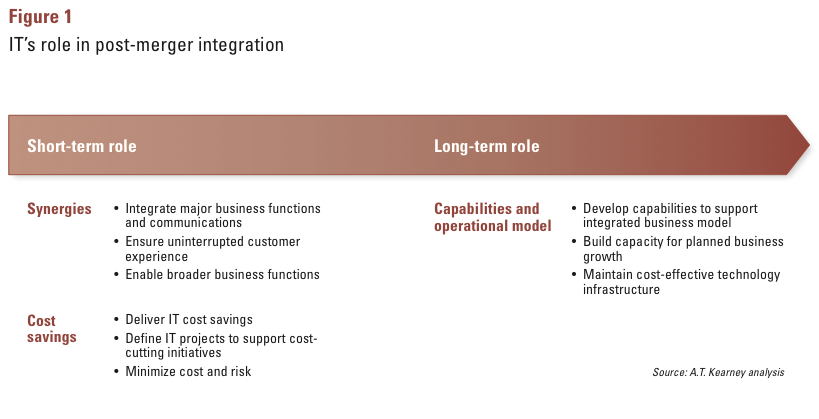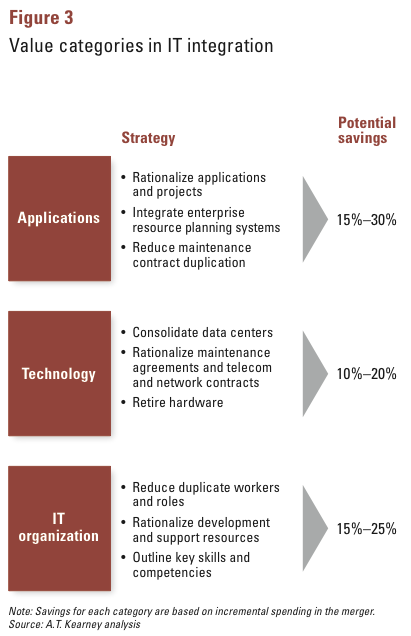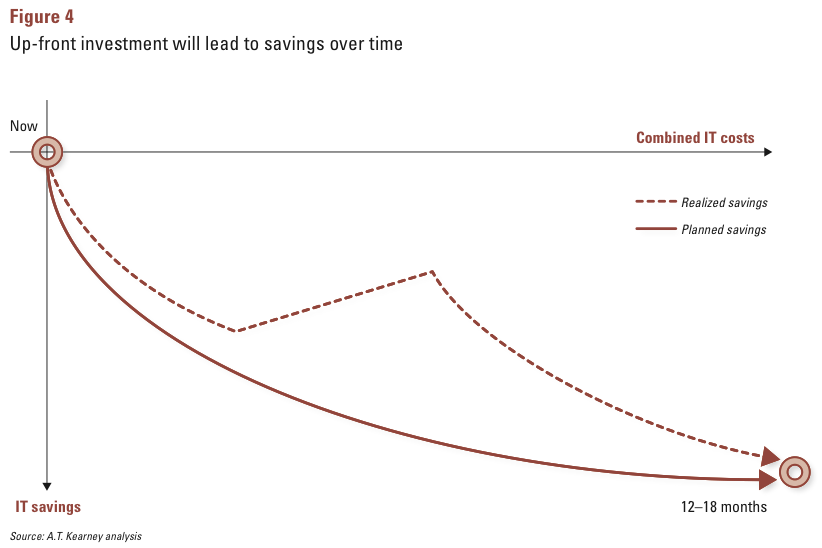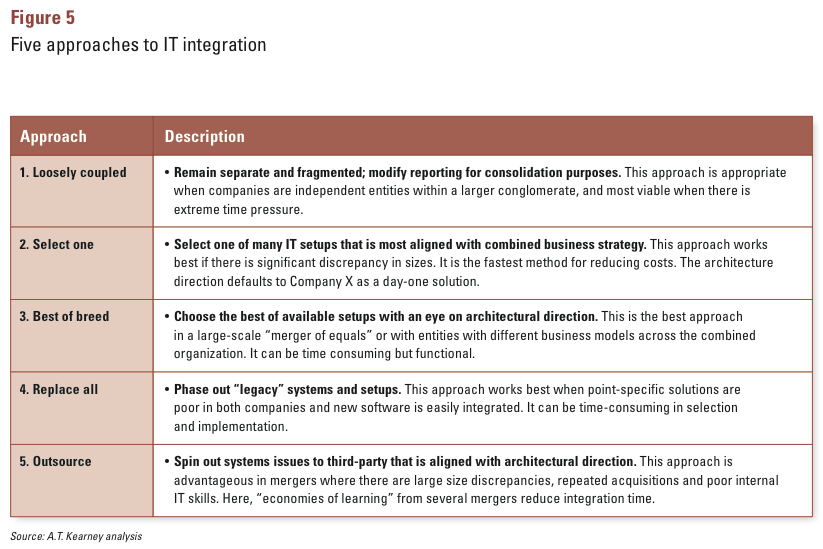
Publications Make Or Break: The Critical Role Of IT In Post-Merger Integration
- Publications
Make Or Break: The Critical Role Of IT In Post-Merger Integration

SHARE:
By Sumit Chandra, Christian Hagen, Jason Miller, Tejal Thakkar and Abha Thakur – A.T. Kearney
A gradual recovery in the stock and credit markets is spurring some stable, cash-rich companies out of their defensive positions and back into mergers and acquisitions. But unlike past M&A environments, there is less margin for error today as analysts and industry experts are expecting strong, consistent results in ever-shorter timeframes. IT will play a vital role in creating a smooth transition within the newly merged company — and delivering quick, reliable value. In short, IT can make or break post-merger prospects.
Amid signs of an economic recovery — though tentative and fitful — more companies are once again testing the M&A waters. The year kicked off with a bang as Kraft Foods acquired Cadbury, Tyco purchased Brink’s Home Security, and United and Continental Airlines agreed to merge and create the world’s largest carrier. But scrutiny of these deals is higher than ever, as board members, stock holders and industry analysts want to see speedy returns from a merger or acquisition and are keeping a close eye on the integration process. The focus is increasingly on IT. As the margin for error shrinks, the role of IT departments in integrating merged companies is taking more of the spotlight.
In the best mergers, IT brings short- and long-term benefits that cannot be ignored, by enabling business synergies, providing business continuity and creating cost savings for the new organization (see figure 1). IT’s role in post-merger integration not only brings real results — it is often the difference between a successful merger and one that never meets expectations.

The Wave of the Future
How does IT play a prominent role in post-merger integration? Savings come from reducing duplicate software applications and licenses, maintenance and network contracts, consolidating data centers, and eliminating telecom contracts. Organizational and support costs go down as duplicate applications and technologies are retired, while unneeded roles are eliminated as skills and competencies are better defined (see figure 2).
But how important are these tasks? Will companies lose customers and market capitalization due to IT failures after mergers? Of course, companies of all sizes face the potential for IT disasters. But after a merger, when disparate systems, applications and resources are combined together, the likelihood of trouble increases greatly after a merger. Some merged companies will survive, yet many others may fail as poorly executed IT integrations bring sales and operations to a halt, and anxious investors offer little extra time to start seeing results. Rather than realizing the great potential benefits of their merger, executives and board members will instead have millions of dissatisfied customers, damaged brand equity and shareholders left in the dust.
Today, senior executives, boards of directors and shareholders are demanding more of their IT organizations during M&A. IT will not only help create the foundation of the new company, but it will also help to maintain the business operations and customer relationships that are so vital for any organization. At a time when profits are down and some companies are struggling just to survive, an IT disaster can threaten the merged entity’s existence. Restoring customer confidence and brand loyalty can take years and costs millions of dollars.
Recent M&A activity highlights the role of IT. In the banking sector, where M&A greatly increased during the economic downturn, IT integration is front and center. According to Banking Technology magazine, HSBC has implemented its “One HSBC” strategy for global IT in post-merger integration. Now, the IT outcome for any HSBC acquisition is a foregone conclusion: that company will rapidly become part of HSBC’s global IT platform, and its existing technologies will be absorbed and redeployed. By quickly addressing technology, HSBC’s managers can plan with certainty and ensure that the company maintains a competitive advantage after the merger.

The Anchor of Post-Merger Integration
As the anchor of the post-merger integration process, IT delivers a sizeable portion of post-merger value. There are several areas where IT plays a major role:
Supporting the business case. The business case that drives a merger almost certainly depends on significant cost savings — both immediate and long-term. IT ushers these in by combining the two companies’ IT cost structures, thus driving future cost savings and reducing operational risks.
Reducing overlap. Merged firms often find that they have many similarities between their IT functions — even when there are seemingly few geographic, industry or product overlaps. Companies can save between 10 and 30 percent by reducing portfolios and outlining the skills and competencies needed for the future IT model (see figure 3). The business plan must clearly articulate the longer-term costs. For example, it can take a year to 18 months to capitalize on some of the upfront costs, such as customized data management, business integration and transaction systems, and leading-edge technologies (see figure 4). These must be included in the business plan so analysts have an accurate view of whether or not the company is on target to meet its projections.
Enabling other synergies. While investors watch for signs of success or failure in a merger, IT is the “glue” that binds the business together, integrating major business functions, improving communications, enhancing processes, and ensuring that customers receive uninterrupted service. This last point is vital: At the end of the day, a company’s customers will decide whether to accept or reject the merged company.
Building long-term capabilities. IT will help build the combined company’s capabilities and operational model. Once the short-term integration work is complete, IT can devote its energy to support the planned business growth of the new company. A cost-effective technology infra- structure is a prerequisite for success.
Providing operational visibility. Post-merger integration is a period of uncertainty for those who work in the combining organizations. Reporting infrastructures, social networking, wikis and dedicated portals can allow leadership to communicate plans and progress to the organization and halt the inevitable rumors. In this way, IT facilitates the integration of the companies, preserves employee morale and ensures productivity in an otherwise turbulent environment.


Your IT? My IT? New IT? Outsource IT?
The right way to integrate IT systems depends on the type of merger and the combined business objectives of the merged organization. Companies merge for a host of reasons — cut costs, growth, enter new markets, capture synergies. In our experience there are five general approaches to integration that offer the best results for the right situation (see figure 5).
Loosely coupled. In a loosely coupled merger, IT systems and organizations undergo only minimal integration. This is a viable option when there are different businesses to support, such as within a holding company, and when there is pressure to complete the integration quickly, as it limits disruptions to critical activities and staffing concerns. However, this approach may not produce the savings or synergies that the company could get by combining IT operations.
Select one. In this scenario, leaders pick the existing IT configuration that best supports the combined firm’s new business strategy. The “select-one” approach works best when the merging entities are sharply different in size; in this case, the new company typically selects the larger company’s architecture. This approach offers the fastest cost savings, yet its nature presents some risks. It requires the merging companies to migrate data, which is more complex than developing new applications. The rapid selection process may also lead to the elimination of highly valuable applications, features and key personnel, or penalties from terminated contracts.
Best of breed. With this method, a company goes through a case-by-case process to select the best applications and people from the available IT portfolios, based on the firm’s planned architecture. The integration strategy is best for merging organizations of comparable size and complexity, and when the merging companies have quite different business models. This approach in particular requires organizational backing in determining what exactly is “best in breed.” It works well when IT staff perceives it to be equitable; organizational distrust could lead to disruptive turf wars that would imperil the whole integration process.
Replace all. When neither side has a strong IT suite, the replace-all integration strategy is most effective, as it swaps all systems for higher- performing IT. Implementation can take a long time, the application selection process can be arduous, and the firm will absorb a high amount of risk due to unfamiliarity. This approach is rarely selected in large mergers, given the scale and importance of the legacy systems. However, they do occur with smaller companies and mergers.
Outsource. When both companies have weak organizations and the M&A process is quick, the new organization can benefit from outsourcing IT operations. The outsourcers’ prior experience will speed up the integration, and with well-written contracts much of the integration risk can be passed on to the outsourcers. The true costs of outsourcing, however, are hard to gauge. Additionally, a vendor will never have the same deep insights into its clients’ core business operations that an internal unit will have.

Procurement and Post-Merger IT Integration
Post-merger integration is the perfect time to save money by reevaluating with an eye toward improving procurement contracts. Let’s look at five major areas of savings:
Comparing prices. A first step post-merger is to assess similar contracts within the new organization. Discrepancies in prices are a chance to reap concessions from vendors. Later, after cutting applications and reducing infrastructure, more savings may be identified.
Concentrating volume. The combination of existing contracts may lead to more volume savings, so reopening contract negotiations may be the right step.
Rationalizing applications. The combined IT footprint will identify redundant applications, which will lead to areas of rationalization. Leading companies start by identifying applications that do not meet business needs or are weak technically or functionally. Reducing infrastructure. Head-count and IT computing infrastructure reductions should lead to reduced IT spending in all areas, including hardware, software, labor, managed services and telecom.
Slimming down the IT function. The post-merger integration period is an opportunity to cut unnecessary or excessive functions. For example, the new company may be able to cut help desks and data centers by shifting work to the acquiring firm’s infrastructure.
IT + Business Strategy = Merger Success
Our five-step approach to integrating IT requires aligning IT with the newly merged company’s business strategy. We used this approach to help several companies save millions of dollars in IT costs while smoothing out often-rocky post-merger transitions. The following outlines the five steps in detail.
Launching day-one activities. The goal on day one is to minimize near-term disruptions, a particularly big concern for any company with customers and transactions. At the start, the long-term vision of the company’s IT function and the business’s short-term viability are woven together as potential risks and risk mitigation strategies are assessed.
The implementation plan examines immediate IT requirements and initiatives in order to offer interim guidance for the merger, before undertaking deeper analysis of the merger plan. This phase is also an opportunity to take stock of each merging entity’s current IT systems and organizations and setting the baselines that will form the foundation of the future IT organization. An analysis of current costs will allow the merged company to estimate potential savings and desired results of the integration, which can be shared with and approved by major stakeholders.
Evaluating integration approaches. Determining the merger approach that is most applicable to your company is essential to a successful IT merger integration. Detailed maps and evaluations of the current state of the merging IT functions — applications, organizations, regions, footprints and infrastructure — along with an assessment of the merging organizations’ preparedness for change will help answer this question. The goal is not only to list current IT capabilities but also to develop an understanding of the major business capabilities of the new combined IT setup, augmented by a plan for migrating and integrating applications.
Enabling synergies. By reviewing and prioritizing IT initiatives prior to day one, the combined IT organization can get a leg up on generating expected revenue and cost synergies. While examining the major opportunities of the merged IT functions, we can also identify and address the associated risks, offering guidance in designing the combined IT setup.
Designing the future IT function. Now the merged company can begin the full design of its new IT function in terms of near-term, intermediate and final states. Identifying major elements of the IT organization, and aligning them with the company’s business objectives, will help IT support all evolving functions in all geographic regions and business areas. A final plan is then set for implementing the IT architecture and achieving the targeted cost savings.
Developing the IT roadmap. In this final phase, integration begins with a transition plan that estimates the investments needed and potential cost savings, taking into account data, application, infrastructure and staffing needs and identifying negotiation opportunities with suppliers and partners. This will help identify the “quick wins” that can generate great savings. Program management is a major part of this phase, including outlining communications plans and risk management strategies that will help mitigate threats and manage stakeholder behavior.
Making the Case for Make-or-Break IT
Several companies have used our IT integration approach to generate great benefits in their M&A activities. Let’s look at a few of these examples:
Belgian financial services firm. At the start of a merger of two large insurance companies and two small banks, IT in all areas was underperforming in terms of costs and services. The firm built a new, consolidated IT organization based on new performance management measures and reporting systems, major infrastructure changes and combined operations and service desks.
A more reliable IT environment reduced downtime by 50 percent, and direct and indirect headcount reductions cut costs by 15 percent.
Global consumer goods company. After this leader in the food and beverage industry made its largest-ever acquisition, its first move was to absorb more than 20 different IT operations into three regional IT setups — jumpstarting the integration by examining infrastructure, data center and applications to design a new IT organization and find cost-cutting opportunities. New governance structures managed all ongoing IT integration efforts, while a two-year IT plan outlined the organization, technology platforms and budget. IT operations costs were cut by 10 to 30 percent, leaving the company free to pursue its longer-term growth agenda and the reason for the acquisition — to increase revenues by 30 percent.
European utility. This large European utility — which owned majority stakes in several utilities — had to combine diverse IT functions into a single IT organization. When the firm evaluated its options, including analyzing its current IT infrastructure and broader IT trends, it found that it could realize $135 million in cost savings by standardizing its application portfolio, harmonizing business processes, improving service levels and minimizing running costs.
A Make-or-Break Imperative
The IT function’s role in post-merger strategy is clear: to ensure that all technology, applications and practices drive short- and long-term success — meaning operational stability, business functionality and economic benefits. While IT will not be alone in driving success, its contribution cannot be overlooked — as IT can make or break post-merger prospects.


Stay up to date with M&A news!
Subscribe to our newsletter


